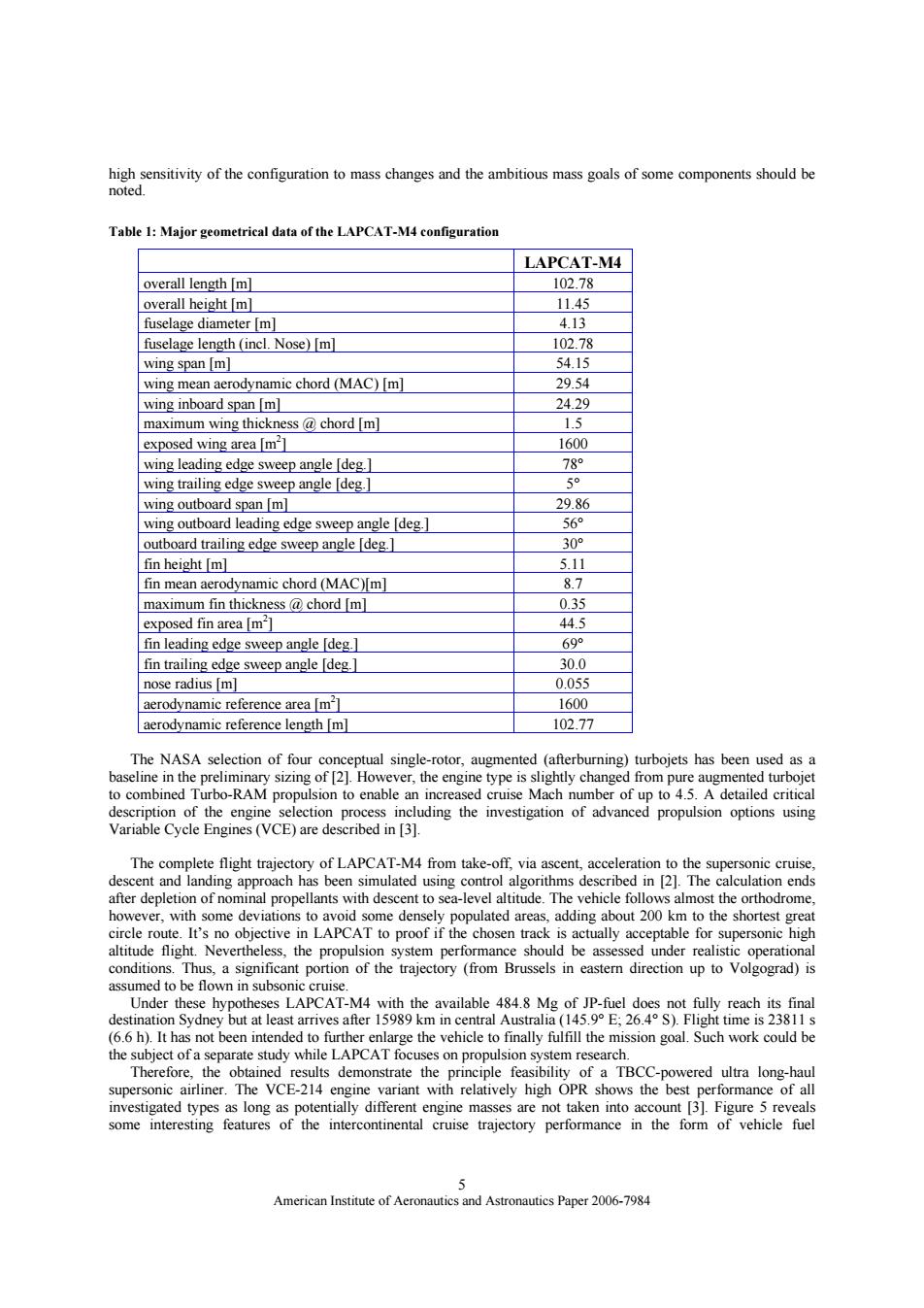正在加载图片...

high sensitivity of the configuration to mass changes and the ambitious mass goals of some components should be noted. Table 1:Major geometrical data of the LAPCAT-M4 configuration LAPCAT-M4 overall length [m] 102.78 overall height [m] 11.45 fuselage diameter [m] 4.13 fuselage length (incl.Nose)[m] 102.78 wing span [m] 54.15 wing mean aerodynamic chord(MAC)[m] 29.54 wing inboard span [m] 24.29 maximum wing thickness chord [m] 1.5 exposed wing area [m2] 1600 wing leading edge sweep angle [deg. 78° wing trailing edge sweep angle [deg.] 5° wing outboard span [m] 29.86 wing outboard leading edge sweep angle [deg. 56° outboard trailing edge sweep angle [deg.] 30° fin height m] 5.11 fin mean aerodynamic chord(MAC)[m] 8.7 maximum fin thickness chord [m] 0.35 exposed fin area [m2] 44.5 fin leading edge sweep angle [deg.] 69° fin trailing edge sweep angle [deg. 30.0 nose radius [m] 0.055 aerodynamic reference area [m2] 1600 aerodynamic reference length [m] 102.77 The NASA selection of four conceptual single-rotor,augmented(afterburning)turbojets has been used as a baseline in the preliminary sizing of [2].However,the engine type is slightly changed from pure augmented turbojet to combined Turbo-RAM propulsion to enable an increased cruise Mach number of up to 4.5.A detailed critical description of the engine selection process including the investigation of advanced propulsion options using Variable Cycle Engines(VCE)are described in [3]. The complete flight trajectory of LAPCAT-M4 from take-off,via ascent,acceleration to the supersonic cruise descent and landing approach has been simulated using control algorithms described in [2].The calculation ends after depletion of nominal propellants with descent to sea-level altitude.The vehicle follows almost the orthodrome, however,with some deviations to avoid some densely populated areas,adding about 200 km to the shortest great circle route.It's no objective in LAPCAT to proof if the chosen track is actually acceptable for supersonic high altitude flight.Nevertheless,the propulsion system performance should be assessed under realistic operational conditions.Thus,a significant portion of the trajectory (from Brussels in eastern direction up to Volgograd)is assumed to be flown in subsonic cruise. Under these hypotheses LAPCAT-M4 with the available 484.8 Mg of JP-fuel does not fully reach its final destination Sydney but at least arrives after 15989 km in central Australia(145.9 E:26.4S).Flight time is 23811 s (6.6 h).It has not been intended to further enlarge the vehicle to finally fulfill the mission goal.Such work could be the subject ofa separate study while LAPCAT focuses on propulsion system research. Therefore,the obtained results demonstrate the principle feasibility of a TBCC-powered ultra long-haul supersonic airliner.The VCE-214 engine variant with relatively high OPR shows the best performance of all investigated types as long as potentially different engine masses are not taken into account [3].Figure 5 reveals some interesting features of the intercontinental cruise trajectory performance in the form of vehicle fuel American Institute of Aeronautics and Astronautics Paper 2006-7984American Institute of Aeronautics and Astronautics Paper 2006-7984 5 high sensitivity of the configuration to mass changes and the ambitious mass goals of some components should be noted. Table 1: Major geometrical data of the LAPCAT-M4 configuration LAPCAT-M4 overall length [m] 102.78 overall height [m] 11.45 fuselage diameter [m] 4.13 fuselage length (incl. Nose) [m] 102.78 wing span [m] 54.15 wing mean aerodynamic chord (MAC) [m] 29.54 wing inboard span [m] 24.29 maximum wing thickness @ chord [m] 1.5 exposed wing area [m2 ] 1600 wing leading edge sweep angle [deg.] 78° wing trailing edge sweep angle [deg.] 5° wing outboard span [m] 29.86 wing outboard leading edge sweep angle [deg.] 56° outboard trailing edge sweep angle [deg.] 30° fin height [m] 5.11 fin mean aerodynamic chord (MAC)[m] 8.7 maximum fin thickness @ chord [m] 0.35 exposed fin area [m2 ] 44.5 fin leading edge sweep angle [deg.] 69° fin trailing edge sweep angle [deg.] 30.0 nose radius [m] 0.055 aerodynamic reference area [m2 ] 1600 aerodynamic reference length [m] 102.77 The NASA selection of four conceptual single-rotor, augmented (afterburning) turbojets has been used as a baseline in the preliminary sizing of [2]. However, the engine type is slightly changed from pure augmented turbojet to combined Turbo-RAM propulsion to enable an increased cruise Mach number of up to 4.5. A detailed critical description of the engine selection process including the investigation of advanced propulsion options using Variable Cycle Engines (VCE) are described in [3]. The complete flight trajectory of LAPCAT-M4 from take-off, via ascent, acceleration to the supersonic cruise, descent and landing approach has been simulated using control algorithms described in [2]. The calculation ends after depletion of nominal propellants with descent to sea-level altitude. The vehicle follows almost the orthodrome, however, with some deviations to avoid some densely populated areas, adding about 200 km to the shortest great circle route. It’s no objective in LAPCAT to proof if the chosen track is actually acceptable for supersonic high altitude flight. Nevertheless, the propulsion system performance should be assessed under realistic operational conditions. Thus, a significant portion of the trajectory (from Brussels in eastern direction up to Volgograd) is assumed to be flown in subsonic cruise. Under these hypotheses LAPCAT-M4 with the available 484.8 Mg of JP-fuel does not fully reach its final destination Sydney but at least arrives after 15989 km in central Australia (145.9° E; 26.4° S). Flight time is 23811 s (6.6 h). It has not been intended to further enlarge the vehicle to finally fulfill the mission goal. Such work could be the subject of a separate study while LAPCAT focuses on propulsion system research. Therefore, the obtained results demonstrate the principle feasibility of a TBCC-powered ultra long-haul supersonic airliner. The VCE-214 engine variant with relatively high OPR shows the best performance of all investigated types as long as potentially different engine masses are not taken into account [3]. Figure 5 reveals some interesting features of the intercontinental cruise trajectory performance in the form of vehicle fuel